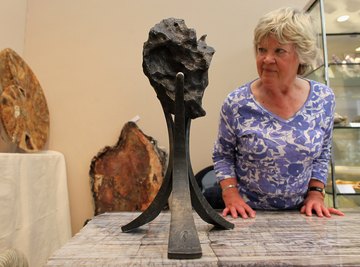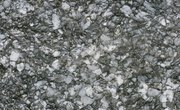
The Earth receives a constant influx of burning debris from space consisting of rocks, portions of planets and remnants of asteroids. These rocks fall all over the Earth, and you can find them among the rocks from this planet. Space rocks have unique features, and you should be able to distinguish extraterrestrial rocks from homegrown ones.
- Magnifying glass
- Measuring cup or container
- Balance or scale
- Tile piece
- Composition book
- Fine-tip permanent marker
- Round 1-inch stickers
Collect a variety of rocks that seem unusual. Place your rocks into different containers based on their characteristics. Assign a number to each rock and record your observations and test results information in a composition book.
If you see rocks for sale in a hobby store with a claim to be meteorites, be skeptical. Ask questions and carefully read the claims on the label before purchasing anything.
Examine your rock samples for the presence of a fusion crust. The thin crust looks black, but years after the meteorite has fallen to Earth, the crust begins to wear away. Check the inside of the rock if it is exposed. A bumpy, irregular feature known as a regmaglypt may appear on the surface or interior of some meteorites. Iron meteorites often have these regmaglypts all over their surface.
Test the density of the rock. Meteorites almost always contain metal, specifically iron. You could easily find nonextraterrestrial, metal-containing rocks or iron slugs on Earth, however. Meteorites have a unique quality because the iron also contains about 7 percent nickel. Meteorites also have a higher density than Earth rocks. You can compare two rocks of similar size. One should be the rock you suspect is a meteorite. Calculate the density of the rocks. First, weigh each rock on the balance. Record the results. Using a measuring cup or container, fill the container halfway. Make a note of how many ounces of water you put in. Now immerse the first rock. Make a note of the water level on the measuring cup. The difference between the first and second measurements is the volume. Divide the weight that you measured by volume you just calculated to get the density. Compare your results with the density of known Earth rocks. A stone meteorite typically has a density of 3.5 grams per milliliter, while an iron meteorite has a density of 8.0 grams per milliliter.
Check to see if the rock has metal by testing it with a magnet. Some fairly common Earth rocks have the minerals hematite or magnetite. Magnetite has a strong magnetic charge, and hematite has a fairly weak charge. Earth rocks with hematite or magnetite may feel heavy compared with other rocks of similar size.
Perform a streak test on your rocks. If you have a piece of white floor tile, you can use it for the test. Turn your tile so that the dull side faces up. Take your rocks one at a time and rub them back and forth over the surface of the tile. Make a note of the streak's color. Do the same for the other rock samples. If you see a black-gray streak, the rock might be magnetite. If you see a reddish-brown streak, you may have hematite. If after rubbing a rock you see no streaks, your rock might be a meteorite.
Find an educational institution that has a geology department, if you want to further pursue your testing. Inquire about having your rocks tested, using a scanning electron microscope energy-dispersive spectrometer. This expensive piece of equipment allows you to accurately identify the chemical composition of the rocks. If the tests show that the rocks have only iron, they are from Earth. Extraterrestrial rocks have a mixture of iron and nickel.
Things You'll Need
Tips
Warnings
References
About the Author
Cheryl Waters Likins is an analyst and writer. Likins obtained a master's degree from Seton Hall University and Bachelor of Science from Upsala College. She completed doctoral-level studies in biomedicine at the University of Medicine and Dentistry of New Jersey. She has been a freelance writer since 2007. Likins' work appears online at Tesi.com (Italy), GolfLink, Trails, eHow, and other publications.
Photo Credits
Oli Scarff/Getty Images News/Getty Images
